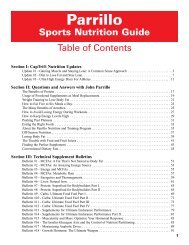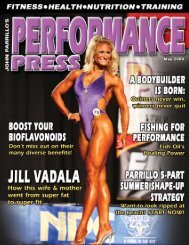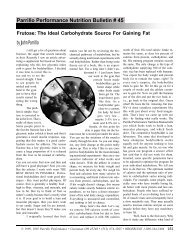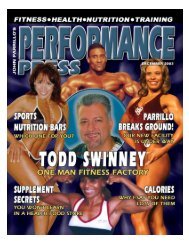A Monthly Magazine For All Bodybuilding, Fitness And - Parrillo ...
A Monthly Magazine For All Bodybuilding, Fitness And - Parrillo ...
A Monthly Magazine For All Bodybuilding, Fitness And - Parrillo ...
You also want an ePaper? Increase the reach of your titles
YUMPU automatically turns print PDFs into web optimized ePapers that Google loves.
News and Views<br />
Low DE Maltodextrin<br />
The Superior Carbohydrate Supplement<br />
by John <strong>Parrillo</strong><br />
starches have different functional properties<br />
than lower DE starches have.<br />
Adding a higher-DE maltodextrin to<br />
food, for example, yields a somewhat<br />
sweeter-tasting final product.<br />
DEs, however, are also important<br />
to fitness-minded individuals like you -<br />
who want to minimize sugar intake in<br />
order to get and stay lean. Sugar - which<br />
includes any sweetener ending in “ose,”<br />
is fat-forming. In short, the lower the<br />
DE of the maltodextrin used, the less<br />
sugar it has and the more starch it contains.<br />
Which is why you’re beginning<br />
to see many sports supplements now<br />
marketed and labeled as having a “very<br />
low DE.”<br />
In the world of nutrition, there are<br />
the RDAs, the DVs, the GI, to name just<br />
a few. Now comes another acronym to<br />
add to the alphabet soup: “DE.” DE<br />
stands for “dextrose equivalence.” It’s<br />
a measurement you’ll be hearing and<br />
reading more about.<br />
DE describes the degree to which<br />
“hydrolysis” (a chemical reaction with<br />
water) breaks down corn starch and<br />
converts it into dextrose (an older name<br />
for the simple sugar, glucose). If the<br />
starch is converted to mostly dextrose,<br />
the resulting “hydrolysate” is said to<br />
have a high DE. Conversely, if less starch<br />
is converted into dextrose, it has a low<br />
DE.<br />
On a scale of zero to 100: Pure starch<br />
has a DE of zero; pure dextrose, a DE of<br />
100. The closer a hydrolysate gets in DE<br />
value to 0, the less sugar content it has.<br />
At this point, you may be asking “So<br />
what?”<br />
At issue is maltodextrin, a slow-release<br />
carbohydrate with performanceenhancing<br />
powers. It forms the carbohydrate<br />
base of many powdered supplements,<br />
drinks, and sports bars - including<br />
many of our own.<br />
Maltodextrin is created through hydrolysis<br />
and assigned a DE value. The<br />
Food & Drug Administration defines<br />
maltodextrins as products having a DE<br />
of less than 20. A maltodextrin with a<br />
DE of 20 is slightly sweeter, with more<br />
dextrose than, say, a maltodextrin with a<br />
DE of 5.<br />
The assigned DE value is of importance<br />
to companies in the food processing<br />
industry, as well as to those in the<br />
supplement industry, when they are formulating<br />
food products. Higher DE<br />
Is this beginning to make sense?<br />
It is thus desirable to choose<br />
maltodextrin-containing foods with a<br />
low DE such as <strong>Parrillo</strong> supplements.<br />
The maltodextrin in our supplements<br />
has a very low DE. What this means is<br />
that you’re guaranteed of getting a superior,<br />
sustained source of energy - but<br />
with no simple, fat-forming sugars.<br />
Don’t be confused over the fact<br />
that some in the food industry have inaccurately<br />
termed maltodextrin as a<br />
simple carb. It is not. In fact, a medical<br />
journal stated in an abstract:<br />
“Maltodextrins are not sweeteners but<br />
are added to a wide variety of food and<br />
drink products for their physical and<br />
chemical properties.” (1)<br />
Maltodextrin is a slow-release, easily<br />
digestible complex carbohydrate<br />
made from natural corn. Unlike simple<br />
sugars, low DE maltodextrin is not fatforming.<br />
It releases into the bloodstream<br />
more slowly than simple sugars like glucose<br />
and sucrose. They release into the<br />
bloodstream immediately, causing a<br />
rapid rise in blood sugar and a burst of<br />
12 John <strong>Parrillo</strong>’s Performance Press • June 2000 Orderline: 1•800•344•3404

















